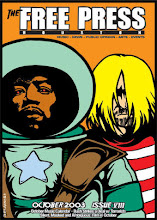Drag Me To Hell

Maybe Sam Raimi didn't set out to make a perfect monster film but Drag Me to Hell exists in that rare category of horror classics. Many films are made but few are chosen to lead the pack. Some will say Raimi has returned to form but to me he was always firing on all cylinders as a director.
The story was written by Raimi and his brother Ivan nearly a decade ago as a short story, recently taken out of the drawer, dusted off and turned into a screenplay. As a nod to another era the Universal logo that opens the movie is from the 80s, the same decade when Raimi made the first two Evil Dead films. Raimi's style doesn't seem so much like a throwback to another era (there's plenty of CGI in DMTH) as it's defined by his singular touch that mixes scary images with comic timing. Nobody pops eyeballs out of demons and into the mouths of babes like Raimi.
Drag Me To Hell only made me scream out loud once and it was more of a "got me off guard" muffled yell than an out and out blood curdling scream. After repeated scares accompanied by loud noises I noticed one passage where the chill factor was brought on by silence. DMTH conjures moments from Raimi's own Evil Dead II: Dead By Dawn as well as the 50s classic Night of the Demon. Raimi's one of a handful of directors who can appropriate classic images from horror and sci-fi films and actually make them better (Joe Dante would be another).
Petite bank loan officer Christine Brown (Alison Lohman) decides she must be heartless in her job if she wants a promotion. Unfortunately the first person she refuses to help happens to be a Hungarian gypsy woman (Lorna Raver) with a glass eye and a penchant for Satanic curses. Christine's fiance Clay (Justin Long) at first hesitates to believe something supernatural has occurred. A fortune teller Christine consults (Dileep Rao) realizes the full potential of the spell, only he himself at first wants nothing to do with her. Reluctantly he reveals more to Christine, and for a price arranges a seance that may be the last hope she has before being, yes you guessed it, drug kicking and screaming to a flaming bottomless pit beneath the surface of normalcy.
Humorous moments spring from the most horrific ideas and include the rampant momentum of the curse leading Christine to take actions outside her realm of comfort. This will be known as the kitty cat scene. Also the interaction with minor characters like Clay's parents and a rival bank loan officer are laced with sarcastic undertones. Drag Me To Hell may be genre filmmaking but it had me glued to the screen from beginning to end rapt with cinematic joy.









